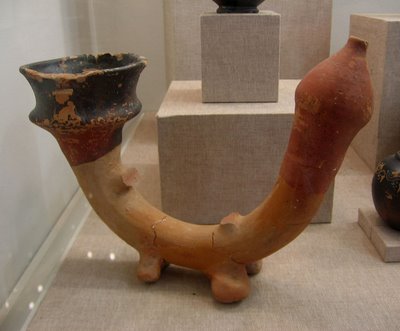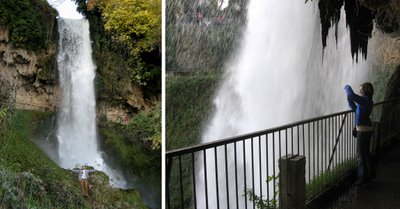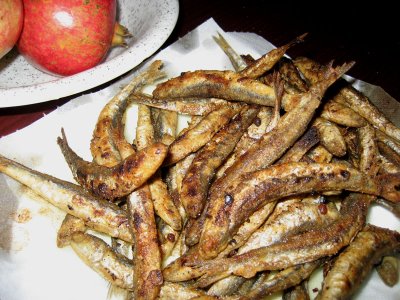This is the post you've all been waiting for. We know you've been wondering: "How can any self-respecting person be in Greece for more than six weeks and not have the gumption to visit even one lousy archaeological site? Heroes and classics and philosophy and wars and whatnot!" Well, wonder no more. Just sit back and enjoy the splendors of the past as they come alive on your screen via The Internet. Just imagine, in a mere two days, these two people (the protagonists):

crammed inside one rented Fiat Panda [incidentally, this spunky little 2004 Car of the Year also comes in diesel 4x4 models, is Nikos' dream car (eat your heart out), and indeed has all the power, speed, and fuel efficiency of a real live panda bear]:

covered 1,013 kilometers, surviving on little more than one half-eaten package of Tostada biscuits:

and took in all of this…
Vergina (Βεργίνα)
The small town of Vergina, overlooking the rolling agricultural plains of south central Macedonia, achieved international fame in 1977 as the site of the ancient city of Aegae, the most important archaeological site excavated in Greece in recent years. The capital of the Macedonians until the 5th century BC, Aegae was the place where Alexander the Great was proclaimed King of the Macedonians (336 BC) once his (also great) father Philip II was laid to rest after being assassinated there during the wedding of his daughter. While there are ruins of the expansive palace:

the real jewel of Vergina is the Royal Tombs. The ancient Macedonians had a penchant for creating elaborate underground tombs, solid stone buildings that they then buried. The resultant large man-made mounds are found scattered all over this region of Greece, but their function backfired somewhat. Rather than sealing the dead off from the world of the living forever, these mounds (with their small forests on top) became tell-tale signs to would-be tomb raiders that riches were there for the plucking. Consequently, archaeologists generally find to their chagrin that tombs were visited before them by people with very different intentions. Fortunately, the magnificent tomb of Philip II escaped such a fate because it was buried BELOW other smaller tombs (nice decoys), leaving modern ruin-hounds with much to gawk at.
The museum and excavation site are first-rate. Four adjacent tombs (including Philip's) were excavated, a museum was built connecting them, and the whole thing was then re-buried just as before:

You'll have to take my word for this since non-flashy photography was difficult in the dark subterrain, but the items on display were fantastic. Found in the tombs, incredibly well-preserved, were cryselephantine couches, suits of armor, glorious gold crowns of delicate oak leaves and acorns (a few very slightly melted-looking acorns attest to the fact that Philip's crown was on his head as his body was consumed in the grand funeral pyre), gold larnaxes, silver banquet sets, innumerable cups and pitchers and flasks ("the dead are always thirsty"), on and on. Very impressive.
Pella (Πελλά)
The next Panda stop was ancient Pella, the birthplace of Alexander the Great and the capital of the Macedonians during both his and Philip's rules as king (even by their time, Aegae had lost its capital significance, functioning mainly as the royal burial site and place for theater…and assassinations). Pella grew into a massive city, built on the Hippodamean system of urban design, a regular grid of perpendicular streets with sophisticated water and sewage systems; but today it's mainly known for its wonderfully preserved mosaic floors, some maintained in situ while others are displayed tastefully in the small museum. These mosaics are composed simply of variously colored stones (pebbles, in some cases); think of the possibilities with future bathroom projects [Roberto: take note]!


Who needs tiles, right?

Watch out, column pose!

Before we hop back in the Panda to the next site, please appreciate the art of the mass production of ceramics, 4th century BC Macedonian style [Roberto, this is for you auch]:

And a final image from the apex of the Hellenistic age (no Naj, we didn't ask):

Edessa (Έδεσσα)
Before the discovery of Vergina, this small mountain town was thought to be the ancient city of Aegae. Stripped of that honor, it is now known (and visited) for its many waterfalls. Edessa certainly has water.

Little concrete canals run all over town, fountains are everywhere, waterfalls, little bridges, even a water museum. If Yestermorrow (www.yestermorrow.org) were to build a town, something not unlike the old town of Edessa might be the result.
Also there to serve the needs of the (almost exclusively Greek) visitors to Edessa is the line of souvenir shops selling every kind of kitchy absurdity, from 2 foot tall clay busts of Sitting Bull to 24 square foot Kurt Cobain suicide tapestries to fur rugs like the one below, apparently made out of some sort of mutant hump-backed polyfox:

"No!" the dangling faux fox family cries, "Please don't go!"

I'm sorry, little ones, but we have more to see elsewhere. [On a side note, Edessa had some of the best crispy pork gyros we've had thus far.]
Delphi (Δελφοί)
If you're like us, when you think of Delphi, you think of pilgrims from all across the ancient world consulting the famous oracle in search of answers to life's questions, political, personal, economic, or otherwise. You think of great kings seeking permission for war, of women desperate for children, men looking for direction. You imagine virgin priestesses of Apollo (Pythia) being drugged and lowered into foul sulfurous chasms, their hysterical rantings being calmly interpreted by high priests, translated into fine and cryptic verses, sufficiently vague to maintain validity in the face of any outcome. Delphi was the omphalos (the naval) of the ancient world, the place where the two eagles that Zeus released from opposite ends of the earth finally met. For over one thousand years, it was the spiritual center of ancient Greece, finally falling into decline once the Romans invaded.
The museum there is a beautiful facility full of artifacts from the ancient site. As difficult as it is to do, the exhibits effectively give you a sense of the reality of this extinguished world, a sense that is deepened by a walk through the extensive ruins outside. Perched high in the foothills of sacred Mount Parnassos, overlooking an endless sea of olive trees, with the real sea beyond, Delphi retains a mystical feel. Seems like a fine candidate for the center of the world.

The Sacred Way (the entrance into the sacred city):

One of the things that struck us most was the idea of how utterly crazy this place must have been in its heyday. Crowded with pilgrims, merchants, priests. Buildings plastered in loud colors, statues and monuments scattered pell-mell everywhere you looked. Trinkets and offerings, animals being sacrificed, music and performances. It seems like the place, though sacred, was a free-for-all in many respects, no one really in charge, a fantastic show, sort of a spiritual Las Vegas or Disneyland. And in such a location. Looking down on the theater, the Temple of Apollo, and the valley beyond:

Heads up! Column pose by the famous Tholos in the sanctuary of Athena Pronaia:

And the same sanctuary from above:

Before moving on, we thought you might enjoy playing one of our favorite games: Spot the Woman with the Inappropriate Shoes for Walking on Uneven Stone Paths (SWISWUSP)!

This sighting was particularly enjoyable as, just moments before, the right heel snapped off and was hanging by a thread. Fashion is king here, and everyone has a ManCrutch just for times like these.
Monastery of Saint Luke (Μονή Οσίου Λουκά)
Don't worry, last stop. If you're this tired reading it, just think how we feel. As a transition from the ancient world to the modern, we ended our weekend with a visit to the Monastery of Saint Luke, a stunning Byzantine church with some of Greece's finest mosaic frescoes out in the middle of nowhere, overlooking a valley of its own.

We were drawn initially to the place because we read that the bones of Saint Luke were held there. Saint Luke! But it turns out that the Luke in question is not the one from the Gospels but rather a local hermit. This took a little active searching to clear up; for while the monastery makes no direct claim on the bones of the Gospel writer (which would boost business, no doubt), it must be said that it also makes no real effort to dispel that idea. In any case, the setting was lovely and we even acquired a few plastic bottles of the local monk-made wine to sip on the terrace beneath an amazing old tree:

Life is difficult.




























 On Sunday afternoons between 1 and 4 and almost any other evening after 9:30, you are likely to find a good percentage of the Volos population at one of the nearly 150 tsipouradika that line the sea port or snuggle in narrow neighborhood streets all over the city. To be Volosian is to dine and drink at tsipouradika, restaurants that serve small bottles of distilled grape liquor known as tsipouro accompanied by little mezedes (appetizers) of seafood for about 3 euros a round (1 bottle + 1 mezedes).
On Sunday afternoons between 1 and 4 and almost any other evening after 9:30, you are likely to find a good percentage of the Volos population at one of the nearly 150 tsipouradika that line the sea port or snuggle in narrow neighborhood streets all over the city. To be Volosian is to dine and drink at tsipouradika, restaurants that serve small bottles of distilled grape liquor known as tsipouro accompanied by little mezedes (appetizers) of seafood for about 3 euros a round (1 bottle + 1 mezedes). The process is easy: sit down at a table, ideally one overlooking the sea (and preferably in the fresh air, far away from smokers – alas, a near impossibility), and a waiter will come, clip a paper cover on your table and ask, almost imperceptibly as the answer is already supposed: “Tsipouro?”
The process is easy: sit down at a table, ideally one overlooking the sea (and preferably in the fresh air, far away from smokers – alas, a near impossibility), and a waiter will come, clip a paper cover on your table and ask, almost imperceptibly as the answer is already supposed: “Tsipouro?”

 Tsipouro, like ouzo, is a strong, clear liquor that turns white when water or ice is added because the aniseed used for flavoring forms microscopic crystals when contacts water. However, if you order your tsipouro choris glycaniso (without anise) as Iago has learned to do, you can add as many ice cubes as you like and your drink, if not your head, will remain clear.
Tsipouro, like ouzo, is a strong, clear liquor that turns white when water or ice is added because the aniseed used for flavoring forms microscopic crystals when contacts water. However, if you order your tsipouro choris glycaniso (without anise) as Iago has learned to do, you can add as many ice cubes as you like and your drink, if not your head, will remain clear. In a group of 3 or 4 people, the first round is often tasty but basic and leaves you wanting more, your tastebuds primed. The second tends to be more adventurous, while quality peaks in the third. After the third round, the quality of the mezedes declines markedly, owing, we hypothesize, to the reduced capacity of the consumer to be discriminating.
In a group of 3 or 4 people, the first round is often tasty but basic and leaves you wanting more, your tastebuds primed. The second tends to be more adventurous, while quality peaks in the third. After the third round, the quality of the mezedes declines markedly, owing, we hypothesize, to the reduced capacity of the consumer to be discriminating.  Ya mas!
Ya mas!

 …harvesting:
…harvesting:

 Maybe 30 Euros a day isn't that bad after all.
Maybe 30 Euros a day isn't that bad after all.

 And the fruits are astonishingly uniform, well-shaped, and HUGE. Here is one next to the leading commercial variety, Hayward
And the fruits are astonishingly uniform, well-shaped, and HUGE. Here is one next to the leading commercial variety, Hayward







 And pulling them out (ding! they're done!):
And pulling them out (ding! they're done!):

